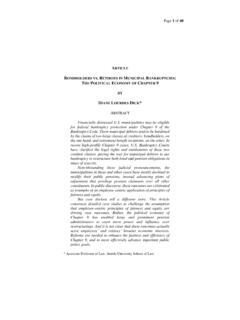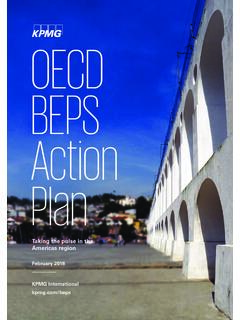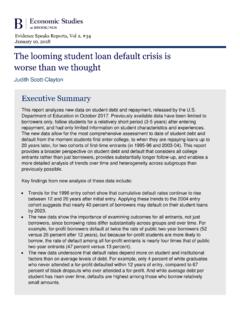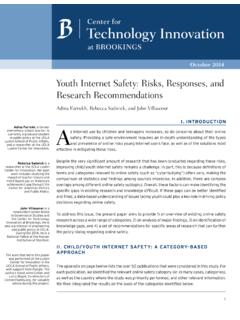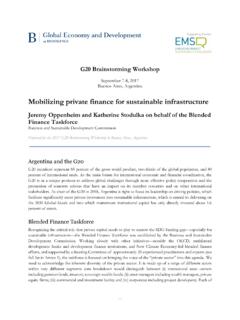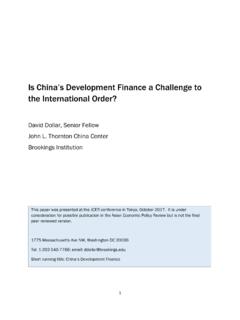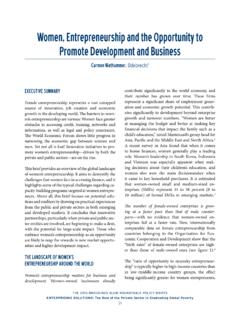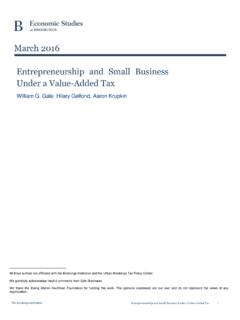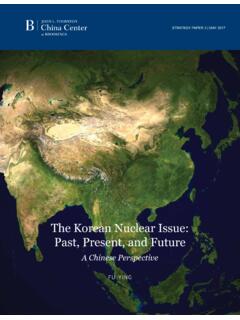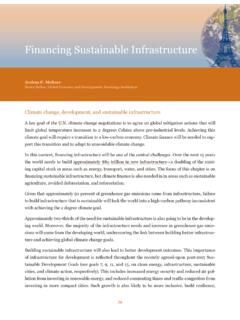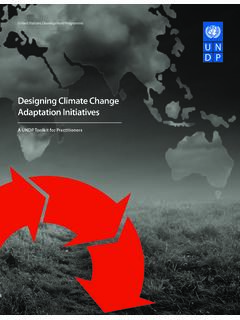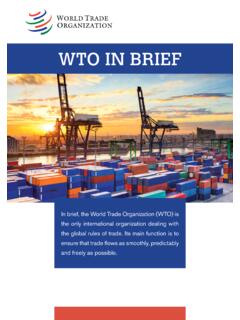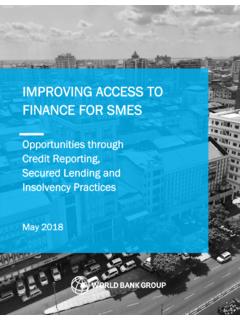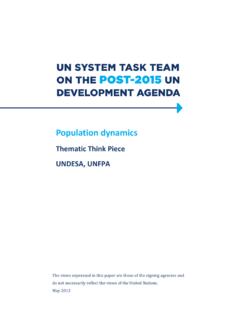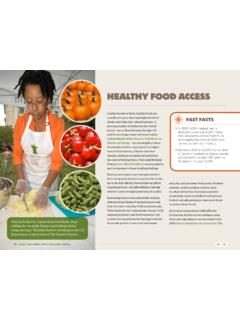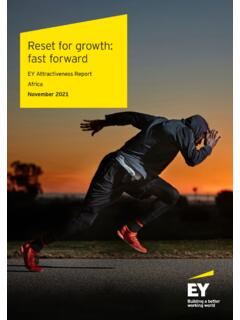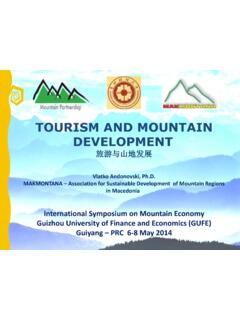Transcription of Social and economic impact of COVID-19
1 Social and economic impact of COVID-19 Eduardo Levy YeyatiFederico FilippiniBROOKINGS GLOBAL WORKING PAPER #158 JUNE 2021 Social and economic impact of COVID-19 Eduardo Levy Yeyati Nonresident Senior Fellow, Global Economy & Development at Brookings Institution Dean of the School of Government at Universidad Torcuato Di Tella Federico Filippini Visiting Professor at Universidad Torcuato Di Tella June 2021 Brookings Global Working Paper #158 Global Economy and Development program at Brookings Acknowledgements Prepared for The Independent Panel of the World Health Organization. We are grateful to Mauricio C rdenas, Ricardo Hausmann, Anders Nordstrom, Rodrigo Vald s, Andr s Velasco, Alejandro Werner, Ernesto Zedillo and members of The Independent Panel for their useful comments, and Joaquin Marandino for excellent research assistance.
2 The usual disclaimers apply. The Brookings Institution is a nonprofit organization devoted to independent research and policy solutions. Its mission is to conduct high-quality, independent research and, based on that research, to provide innovative, practical recommendations for policymakers and the public. The conclusions and recommendations of any Brookings publication are solely those of its author(s), and do not reflect the views of the Institution, its management, or its other scholars. Brookings recognizes that the value it provides is in its absolute commitment to quality, independence and impact . Activities supported by its donors reflect this commitment and the analysis and recommendations are not determined or influenced by any donation.
3 A full list of contributors to the Brookings Institution can be found in the Annual Report at 1. Introduction .. 1 2. The costs of COVID-19 in 3 stages .. 4 Stage 1: The macroeconomic impact .. 4 Stage 2: The fiscal reaction .. 7 Stage 3: The recovery .. 9 3. Initial conditions .. 12 Fiscal space .. 12 State capacity .. 13 The labor market channel .. 14 Initial conditions and economic impact .. 16 4. Dealing with the pandemic .. 20 Cross-country evidence on lockdowns and economic activity .. 21 Fiscal response to the pandemic .. 24 5. The role of IFIs .. 31 6. Estimating the economic costs of the pandemic .. 33 7. Final remarks .. 36 References .. 38 Brookings Institution 1 1. IntroductionThe impact of the pandemic on world GDP growth is massive.
4 The COVID-19 global recession is the deepest since the end of World War II (Figure 1). The global economy contracted by 3,5 percent in 2020 according to the April 2021 World economic Outlook Report published by the IMF, a 7 percent loss relative to the percent growth forecast back in October 2019. While virtually every country covered by the IMF posted negative growth in 2020 (IMF 2020b), the downturn was more pronounced in the poorest parts of the world (Noy et al. 2020) (Figure 2). Figure 1. Global GDP growth in a historical perspective Sources: Bolt et al. (2018), Kose, Sugawara, and Terrones (2019, 2020), and IMF-WEO Apr-2021. Shaded areas refer to global recessions. The impact of the shock is likely to be long-lasting. While the global economy is expected to recover this year, the level of GDP at the end of 2021 in both advanced and emerging market and developing economies (EMDE) is projected to remain below the pre-virus baseline (Figure 3).
5 As with the immediate impact , the magnitude of the medium-term cost also varies significantly across countries, with EMDE suffering the greatest loss. The IMF (2021) projects that in 2024 the World GDP will be 3 percent (6 percent for low-income countries (LICs)) below the no-COVID scenario. Along the same lines, Djiofack et al. (2020) estimate that African GDP would be permanently 1 percent to 4 percent lower than in the pre-COVID outlook, depending on the duration of the crisis. -12-10-8-6-4-202468187118761881188618911 8961901190619111916192119261931193619411 9461951195619611966197119761981198619911 99620012006201120162021 GDP growthPer capita GDP growthBrookings Institution 2 Figure 2. Global GDP growth 2020 Source: IMF-WEO Apr-2021.
6 Note: AE = Advance economies; Emerging Asia ex. CHN = emerging and developing Asia excluding China; EM. Eur = Emerging and developing Europe; LAC = Latin America and the Caribbean; MECA = Middle East and Central Asia; SSA = sub-Saharan Africa. Figure 3. Quarterly World GDP (GDP forecast in Jan-2020 vs. Jan-2021, 2019 Q1 = 100) Source: IMF-WEO Jan-2021. Note: dashed lines indicated estimates from Jan-2020 World economic Outlook Update. The pandemic triggered a health and fiscal response unprecedented in terms of speed and magnitude. At a global scale, the fiscal support reached nearly $16 trillion (around 15 percent of global GDP) in 2020. However, the capacity of countries to implement such measures varied significantly. In this note, we identify three important pre-existing conditions that amplified the impact of the shock: -9-8-7-6-5-4-3-2-10Em.
7 Asiaex. CHNLACSSAMECAEMDEW orldEm. :Q42020:Q12020:Q22020:Q32020:Q42021:Q120 21:Q22021:Q32021:Q42022:Q12022:Q22022:Q3 2022:Q4 ChinaAesEMDEB rookings Institution 3 Fiscal space: The capacity to support household and firms largely depends on access to international financial markets, State capacity: Fast and efficient implementation of policies to support household and firms requires a substantial state capacity and well-developed tax and transfer infrastructure; and Labor market structure: A large share of informal workers facing significant frictions to adopt remote working, and high levels of poverty and inequality, deepen the deleterious impact of the crisis. Additionally, the speed and the strength of the recovery will be crucially dependent on th e capacity of the governments to acquire and roll out the COVID-19 vaccines.
8 This paper presents a succinct summary of the existing economic literature on the economic and fiscal impact of the pandemic, and a preliminary estimate of the associated economic cost. It documents the incidence of initial conditions (with a particular focus on the role of the labor market channel) on the transmission of the shock and the speed and extent of the expected recovery, summarizes how countries attempted to attenuate the economic consequences and the international financial institutions assisted countries, reports preliminary accounts of medium-term COVID-related losses, and concludes with some forward-looking considerations based on the lessons learned in 2020. Brookings Institution 4 2. The costs of COVID-19 in 3 stages The COVID-19 shock can be interpreted as a combination of supply and demand shocks (Baqaee and Farhi, 2020; Caballero and Simsek, 2020; Guerrieri et al.)
9 , 2020). The supply shock was mainly driven by the restriction of activities due to lockdowns and distancing measures to contain the spread of the virus, causing sectors to struggle to keep up with demand, while the demand shock reflected both the income effect suffered by workers in restricted activities, as well as the diminished mobility and changes in consumption patterns due to contagion concerns (IMF 2020b). Stage 1: The macroeconomic impact The COVID shock propagated quickly across countries causing a synchronized negative impact . More than 90 percent of the global economy experienced a contraction in per capita GDP, the highest share of countries simultaneously contracting since the Great Depression of 1930-32 (World Bank Global Outlook, 2020).
10 The shock propagated through three key channels: (i) a disruption of global value chains, (ii)` restrictions to international mobility, which affected economies and activities differently, depending on their exposure and preparedness; and (iii) a reduction in cross-country remittances. Trade experienced a short-lived but deep dive (Figure 4). Goods trade fell rapidly, adding to the economic decline in manufacturing countries, but recovered quickly, reflecting the substitution of demand from contact-intensive services (impaired by COVID-related restriction) to goods, and the considerable resilience of global value chains to transitory disruptions in the first semester (The World Bank, 2021). Predictably, services trade remained below pre-crisis levels due to travel restrictions.
